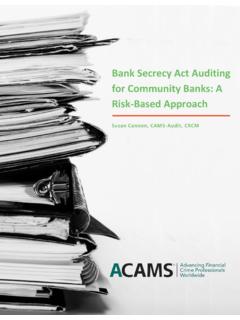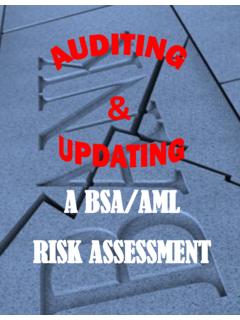Transcription of Introduction - ACAMS
1 1 Introduction With 22 states and the District of Colombia allowing the use of marijuana for medicinal purposes and two of those states, Colorado and Washington, legalizing marijuana for recreation drug use, financial institutions (FIs) are faced with addressing the challenges of the legalization of marijuana at the state level while it remains illegal at the federal level. Outside of the more evident legal and political challenges that have been discussed in several recent articles published throughout the industry and which will not be the main focus of this paper, FIs must weed through those challenges to ultimately address what challenges impact their FI.
2 Three noteworthy challenges faced by a FI regarding the marijuana industry are as follows: The FI s decision whether or not to offer services to a marijuana -related business. For this paper a marijuana -related business is defined as a business that grows, processes, transports and dispenses marijuana such as, but not limited to, marijuana dispensaries and/or medical marijuana farms. If a FI is going to offer services, implementing a monitoring program for marijuana -related businesses that aligns with best practices and industry standards.
3 The FI s responsibilities to review existing anti-money laundering (AML) programs to ensure adequate monitoring and due diligence controls are in place to identify and report emerging trends and associated risks as a result of the industry not having access to FIs. The heart of these challenges exist as a result of the lack of harmony between state and federal laws not acting with effective, direct guidelines for an industry in its infancy. Earlier in 2014, the Financial Crimes Enforcement Network (FinCEN) and the Justice Department provided guidance for FIs on servicing marijuana -related businesses.
4 However, this guidance offered very little clarity on what specific compliance obligations and methods should be implemented to mitigate the The objectives of this white paper are to assist FIs by: Presenting current viewpoints of banking marijuana -related businesses Interpreting regulatory guidance issued by the Department of Justice (DOJ) and FinCEN Proposing guidance to enhance marijuana law to allow for transparency to FIs Formulating best practices and industry standards for FIs to effectively monitor marijuana -related business accounts Addressing risks involved with marijuana -related businesses Discussing alternative banking methods used by marijuana -related businesses The purpose of this paper is to give industry professionals and financial institutions a better understanding of the potential ramifications of banking
5 marijuana -related businesses. If a financial institution chooses to bank the marijuana industry, the paper will assist a FI in offering financial services to marijuana -related 1 Kneiff, Ben. Legalized marijuana Stinking Challenge or Budding Opportunity? (February, 19, 2014). Financial Crime Partners. May 14, 2014 2 businesses while implementing a compliance monitoring program that aligns with the issued guidance and existing regulations.
6 While the proposed recommendations are not exhaustive, it will provide a foundation on which to begin setting industry standards for due diligence requirements. Current Viewpoints The federal government regulates marijuana as a scheduled 1 drug through the Controlled Substance Act (CSA) (21 811), which means the federal government views marijuana as highly addictive and having no medicinal The cultivation, possession and distribution of marijuana are illegal under the Federal Controlled Substances Act, and any proceeds deriving from those transactions would be proceeds of an illegal transaction.
7 Individual state laws do not always conform to the federal standard. Acknowledging the use, sale and possession of marijuana in the is still illegal under federal law; several states have legalized marijuana in some form. As a result of the differing viewpoints between state and federal law, the Treasury Department and Justice Department have issued separate advisories intended to give banks confidence that if they are compliant with the guidance, they will not be prosecuted for providing services to legitimate state-licensed marijuana businesses.
8 The Treasury Department issued FIN-2014-G001 Bank Secrecy Act (BSA) Expectations Regarding marijuana -Related Businesses on February 14, 2014, and the DOJ issued a memorandum entitled Guidance Regarding marijuana -Based Financial Crimes. The memorandum issued by the DOJ is a follow-up to an August 29, 2013 memo also containing guidance to federal prosecutors concerning marijuana enforcement under the Controlled Substance Act. The memorandum issued by the DOJ does not grant a safe harbor from prosecution, but directs prosecutors and regulators to give priority to cases where FIs have failed to adhere to the memorandum.
9 The guidance issued by the Treasury Department clarifies how FIs can provide services to marijuana businesses while maintaining their obligations to comply with the BSA. Additionally, the guidance allows access to financial services for marijuana -related businesses while ensuring their activity is transparent and there are appropriate AML safeguards implemented. Safeguards may include, but are not limited to, adequate customer due diligence (CDD), ongoing monitoring, enhanced due diligence (EDD), and proper suspicious activity report (SAR) reporting.
10 SAR reporting has been enhanced to include a new classification of SARs related exclusively to the marijuana industry. 2 United States Department of Justice. Office of Diversion Control. Title 21 United States Code (USC) Controlled Substance Act: Subchapter I Control and Enforcement. August 13, 2013 3 Even so, FIs have been reluctant to offer financial services to marijuana -related businesses. "Banks are responsible to regulators, most of which are independent and uncontrolled by the president's executive branch.










